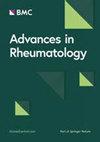Patients with longstanding pPatients with longstanding psoriatic arthritis can achieve DAPSA remission or low disease activity and it correlates to better functional outcomes: results from a Latin-American real-life cohort
IF 2
4区 医学
Q3 RHEUMATOLOGY
引用次数: 0
Abstract
Patients with psoriatic arthritis (PsA) experience reduced physical function and impaired quality of life. Better patient-reported functional outcomes are found when lower disease activity is achieved. To evaluate the variation of physical function by HAQ-DI over time in PsA patients treated with standard therapy in a real-life setting: to verify predictors of achieving a minimum clinically important difference (MCID) in function by HAQ-DI (ΔHAQ-DI ≤ − 0.35) and to measure the impact of achieving REM/LDA on long-term function by HAQ-DI. This is a longitudinal analysis of a real-life retrospective cohort. Data from PsA patients with at least 4 years of follow-up in the PsA clinic from 2011 to 2019 were extracted from electronic medical records. The variations of physical function by HAQ-DI and disease activity by DAPSA over time were calculated. A multivariate hierarchical regression model was applied to verify predictors of MCID in HAQ-DI. A comparison of HAQ-DI variation between patients with DAPSA REM, LDA, moderate and high disease activity was made using the generalized estimating equation model (GEE), adjusted by Bonferroni test. The Spearman correlation method was applied to verify the correlation of ΔDAPSA and ΔHAQ-DI over time. Statistical analysis was performed in SPSS program version 21.0. Seventy-three patients were included in the analysis. Physical function measured by HAQ-DI was determined by PsA disease activity measured by DAPSA (p < 0.000). A moderate and statistically significant correlation between ΔDAPSA and ΔHAQ-DI was observed (rs = 0.60; p < 0.001). Only patients in DAPSA REM demonstrated a constant decline in HAQ-DI scores during the follow-up. White ethnicity and older age at baseline were predictors for not achieving MCID in HAQ-DI [RR 0.33 (0.16–0.6795% CI p = 0.002) and RR 0.96 (0.93–0.9895% CI p < 0.000), respectively, while higher scores of HAQ-DI at baseline were predictors of achieving MCID [RR 1.71 (1.12–2.6095%CI p = 0.013)]. In PsA, patients who maintained DAPSA REM/LDA over time had better long-term functional outcomes. Higher HAQ-DI scores at baseline, non-white ethnicity and younger age were predictors for achieving a clinical meaningful improvement of HAQ-DI.久治不愈的银屑病关节炎患者可实现 DAPSA 缓解或低疾病活动度,这与更好的功能预后相关:来自拉丁美洲真实生活队列的结果
银屑病关节炎(PsA)患者的身体功能减退,生活质量下降。当疾病活动度降低时,患者报告的功能结果会更好。目的是评估在现实生活中接受标准疗法的PsA患者随着时间推移身体功能HAQ-DI的变化情况:验证HAQ-DI功能达到最小临床意义差异(MCID)(ΔHAQ-DI≤-0.35)的预测因素,并测量达到REM/LDA对HAQ-DI长期功能的影响。这是一项对现实生活中的回顾性队列进行的纵向分析。研究人员从电子病历中提取了2011年至2019年在PsA诊所随访至少4年的PsA患者的数据。通过 HAQ-DI 和 DAPSA 计算了随时间变化的身体功能和疾病活动性。应用多变量分层回归模型来验证 HAQ-DI 中 MCID 的预测因素。使用广义估计方程模型(GEE)比较了DAPSA REM、LDA、中度和高度疾病活动患者的HAQ-DI变化,并通过Bonferroni检验进行了调整。斯皮尔曼相关法用于验证ΔDAPSA和ΔHAQ-DI随时间变化的相关性。统计分析在 21.0 版 SPSS 程序中进行。共有 73 名患者参与了分析。通过 HAQ-DI 测定的身体功能取决于通过 DAPSA 测定的 PsA 疾病活动度(P < 0.000)。ΔDAPSA和ΔHAQ-DI之间存在中度统计学意义的相关性(rs = 0.60; p < 0.001)。只有 DAPSA REM 患者的 HAQ-DI 评分在随访期间持续下降。白种人和基线年龄较大是 HAQ-DI 未达到 MCID 的预测因素[RR 分别为 0.33 (0.16-0.6795%CI p = 0.002) 和 RR 0.96 (0.93-0.9895%CI p < 0.000)],而基线 HAQ-DI 分数较高是达到 MCID 的预测因素[RR 1.71 (1.12-2.6095%CI p = 0.013)]。在PsA中,长期保持DAPSA REM/LDA的患者具有更好的长期功能预后。基线时较高的 HAQ-DI 分数、非白人种族和较年轻的年龄是实现有临床意义的 HAQ-DI 改善的预测因素。
本文章由计算机程序翻译,如有差异,请以英文原文为准。
求助全文
约1分钟内获得全文
求助全文
来源期刊

Advances in Rheumatology
Medicine-Rheumatology
CiteScore
4.00
自引率
4.30%
发文量
41
审稿时长
53 weeks
期刊介绍:
Formerly named Revista Brasileira de Reumatologia, the journal is celebrating its 60th year of publication.
Advances in Rheumatology is an international, open access journal publishing pre-clinical, translational and clinical studies on all aspects of paediatric and adult rheumatic diseases, including degenerative, inflammatory and autoimmune conditions. The journal is the official publication of the Brazilian Society of Rheumatology and welcomes original research (including systematic reviews and meta-analyses), literature reviews, guidelines and letters arising from published material.
 求助内容:
求助内容: 应助结果提醒方式:
应助结果提醒方式:


